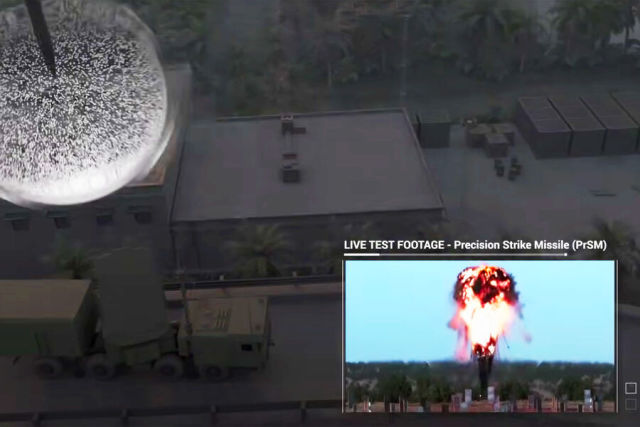The US has successfully tested the operational-tactical missile PrSM, the future replacement of ATACMS
Lockheed Martin Corporation together with the US Army conducted tests of a promising operational-tactical missile PrSM. The military observer of Gazeta dealt with the tactical and technical characteristics of the new product.En" Mikhail Khodarenok.
Lockheed Martin has reported on the successful completion of production qualification flight tests of the PrSM rocket. The work was carried out jointly with the US Ground Forces, M142 HIMARS installations were used for test launches. As a result of the tests, the Precision Strike Missile successfully hit the target.
The INF factor
The development of PrSM started back in 2017, the goal is to create a high-precision tactical missile of a new generation with an official initially declared range from 60 to 499 km to replace the existing family of American Lockheed Martin MGM-140 ATACMS tactical missiles.
At first, the project was limited by the provisions of the Treaty on Intermediate-Range and Shorter-Range Missiles (INF) between Washington and Moscow. The termination of the INF Treaty in August 2019 untied the hands of the United States in the issue of creating a missile capable of covering a distance of over 500 km.
And most likely, the firing range of the PrSM will be much greater.
The ground forces of the US Armed Forces are already studying potential product improvements that can provide the PrSM missile with a combat radius, which is called "medium capabilities" in the US infantry. This characteristic has been defined as over 1,600 km (1,000 miles). That is, about three times more than the PrSM missile currently possesses.
At the same time, as a means of long-range fire attack, the US Military has a self-propelled howitzer developed under the ERCA program (Extended Range Cannon Artillery - extended-range artillery), and a new long-range hypersonic weapon Long-Range Hypersonic Weapon (LRHW).
"The weapon that changes everything"
The opening of the PrSM program was preceded by a strategic study of the US Ground Forces, in which the military wondered about the fire defeat of a likely enemy. Based on the results of the work done, it was concluded that they need a medium-range missile to fill the gap in the combat radius of 500-2000 km, and that such a product needs to be put into service in a fairly short time, at least by 2023.
As US Brigadier General John Rafferty noted, the missile being developed should change the rules of the game. Even before increasing the range of the missile, he called it a "killer" of Russian air defense systems, such as the S-400 Triumph.
PrSM is being developed by the USA as part of the LRPF (Long Range Precision Fires - "High-precision long-range shooting") project. The program involves the creation of the first of its kind high-speed long-range ground-based missile designed to destroy command posts and communication centers of a potential enemy, helicopter pads and army aviation groups, air defense positions, defeating enemy units and formations in areas of operational purpose.
Its flight range should be at least three times longer than that of the systems currently in service with the US Army. In addition, the developers of the LRPF program should take into account that the Russian armed forces have the most modern air defense system in the world and it is necessary to take all measures to reduce the vulnerability of new weapons from Russian anti-aircraft guided missiles.
How the US can use PrSM
The PrSM missile should be launched from standard launchers of the American M270A1 MLRS and M142 HIMARS missile systems. Unlike ATACMS, the M270A1 MLRS launcher should have four PrSM missiles (instead of two ATACMS), and the M142 HIMARS launcher should have two PrSM missiles (instead of one ATACMS).
High-precision strike missiles of the PrSM type are primarily designed for firing on the main groupings of the troops of a likely enemy, its means of nuclear attack, strikes on aviation at advanced airfields, the most important air defense facilities (starting positions of anti-aircraft missile systems (primarily, the S-400 Triumph air defense system) and radio-electronic means of radio-technical troops), control points. One of the main tasks of the combat use of high-precision strike missiles of the PrSM type is the disorganization of the control of enemy troops and weapons.
Anti-aircraft missile systems and complexes with the so-called potential of non-strategic missile defense will be able to fight promising American missiles. These include, first of all, the S-400 Triumph air defense system, the S-300V4 (Antey-2500), the S-350 Vityaz air defense system, the Buk-M3 air defense system.
The opinion of the author may not coincide with the position of the editorial board.
Biography of the author:
Mikhail Mikhailovich Khodarenok is a military columnist for the newspaper.Ru", retired colonel.
He graduated from the Minsk Higher Engineering Anti-Aircraft Missile School (1976), the Military Air Defense Command Academy (1986).
Commander of the S-75 anti-aircraft missile division (1980-1983).
Deputy Commander of the anti-aircraft missile regiment (1986-1988).
Senior Officer of the General Staff of the Air Defense Forces (1988-1992).
Officer of the Main Operational Directorate of the General Staff (1992-2000).
Graduated from the Military Academy of the General Staff of the Armed Forces of Russia (1998).
Columnist of "Nezavisimaya Gazeta" (2000-2003), editor-in-chief of the newspaper "Military-Industrial Courier" (2010-2015).
Mikhail Khodarenok

